There are many types of aquarium fish that are great for breeding at home. In order for the inhabitants of the home reservoir to feel wonderful and enjoy the beauty, it is necessary to create optimal conditions for them. In this article, we will consider one of the most common types of barbs.
Characteristic
The mossy barbus, which is also called the green mutant barbus, is very popular among aquarists due to its expressive appearance. Experts note that with age, the barbus loses its former brightness, but retains its beauty and charm. The active behavior of the fish is also noted. This species is great for beginner aquarists due to the fact that it is not demanding on care and maintenance. Despite this, you need to take care of the fish and create special conditions for them. Like other varieties, the mossy barbus loves clean water and a stable temperature.
This variety is a mutation of the Sumatran barbus. The new species is more attractive than its ancestor. Its color is saturated, dark green, with a blue iridescent tint. Hue depends on the lighting.
The trunk of the barbus of a mutant is rounded, the head is pointed. The maximum sizes reach 7 centimeters, however, in artificial conditions they are smaller.
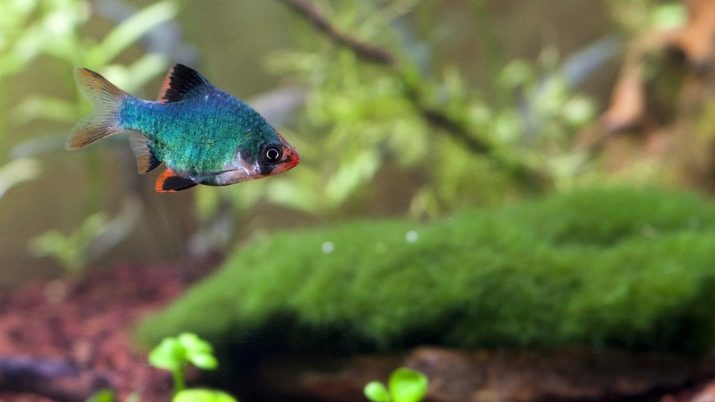
If you properly care for the underwater inhabitants and feed quality food, fish are able to live 5 years.
The mossy species lacks black stripes that are characteristic of the Sumatran species. When it comes to spawning, a red color appears on the face. There are also scarlet marks on the fins.
Barbs include many species, each of which is distinguished by its expressive color. The following types are popular: black, fiery, striped, cherry. In their colors, there are such colors: blue, green, orange, golden, silver. They are similar in nature and conditions of detention.
The first records regarding this species are dated 1855. Barbuses can be found in Thailand, Borneo, Sumatra and Cambodia. Certain populations live in America, Australia, Columbia, as well as within the borders of Singapore.
Under natural conditions, fish live in rivers and streams that flow in a green and dense jungle. Such places are ideal for their living due to the high oxygen content in the water.
As food in the wild, fish feed on algae and small insects.
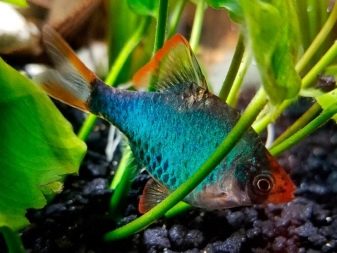
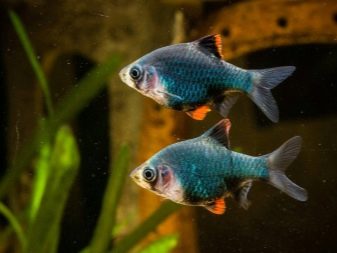
Content Features
The mossy barbus easily transfers the change of an aquarium. In this case, do not worry that the fish will become inactive or lose their appetite. The content of barbs in the school is an important component for the normal behavior of fish. A certain hierarchy is established, due to which the excessive activity and arrogance of individual individuals are reduced. It is important that the water in the aquarium is clean and thoroughly aerated. For this, special equipment is used.
The mossy appearance of barbs feels great in small flocks (up to 7 fish). If the number of individuals is less, barbs begin to behave sharply and even aggressively. Living in a pack reduces their rudeness and insolence. In the aquarium, it is better not to hook slow fish with long fins.
Thanks to their activity, barbs get along well with other moving species, such as Conga, Danio rerio and Thornia. You can not keep in the same aquarium with mossy barbs of cockerels, marble gourams and laliuses.
Great in one flock will look green mutant and Sumatran barbus. They are equally active, but the appearance of these two individuals varies significantly. The contrast of colors will not go unnoticed.
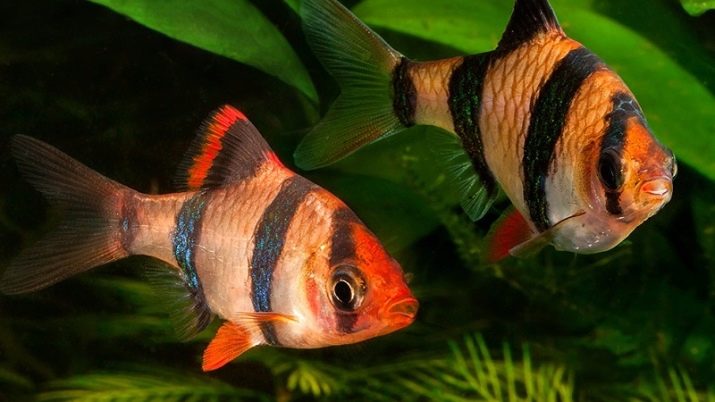
Frozen, as well as live types of feed are great as food for them. Artificial food is also used. It is recommended to diversify the diet of these pets. Such a feeding system will provide the fish with good health and strong immunity. As a basis for the diet, experts recommend choosing high-quality cereals. In the form of an addition, it is better to use a tubifex, bloodworm, coronet, as well as artemia. The menu may include spirulina flakes.
If you choose an aquarium for 7 fish, make a choice in favor of capacities of at least 70 liters. It is recommended to choose long aquariums. Tall walls are also important, as barbs can jump out of the water. If you notice increased activity of fish, be sure to install the lid on the aquarium.
Ideal water parameters:
- pH - from 6.0 to 8.0;
- dH - from 5 to 10;
- optimal temperature varies from 23 to 26 degrees Celsius.
In nature, barbs live in soft water. To maintain cleanliness, be sure to install a high-quality and efficient filtration system in the aquarium. On sale you will find many models that are designed for different volumes. Do not forget about the air supply unit (aerator).
Even when using the most powerful and modern equipment, water should be changed periodically. Fluid change and soil cleaning should take place once a week.

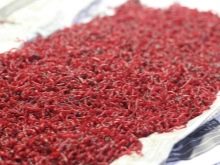

Fish feel great among the dense flora, however, in order to save enough space for their swimming, experts advise planting algae in the corners and in dark areas of the aquarium. For example, near the back wall. Large foliage plants are great for this. Also, the underwater flora can become a source of food, but only if the fish feel a lack of plant food.
Bright and excessive light negatively affects the health and behavior of fish. The light should be soft and diffused. The maximum daylight hours should not exceed 16 hours. If you want the aquarium to become an accent of the interior, think carefully about its design design. Medium-sized stones, as well as natural driftwood, are great as decorative elements. Fish will use them as shelters. This design will contribute to the comfort of underwater residents. The optimum height of the soil should be about 5 centimeters. To fill the tank, sand with medium-sized gravel is suitable.
Choose a calm place for the aquarium. According to experts, barbs are resistant to stress, but loud noise can harm them.


Breeding
It is very difficult to determine the gender of barbs before their full puberty.
Adults vary in the following ways.
- The female has a more rounded shape and a large belly.
- The male has a color that is much brighter and more expressive than that of the female representatives. Also, males are smaller in size. When spawning on the muzzle, they have noticeable red marks.
It is easy to propagate this species. The fish reach puberty at the age of 4 months. During this period, their body length already reaches 3 centimeters. To start breeding, you need to choose a couple from the pack. Choose the most attractive and active individuals. These are spawning fish. They do not care about offspring at all and often eat caviar. In this regard, it will need a separate container with a protective mesh at the bottom.
Before spawning begins, a couple are abundantly fattened. Use of live food is recommended. It lasts for two weeks. After a couple of barbs are transplanted into a separate spawning ground.
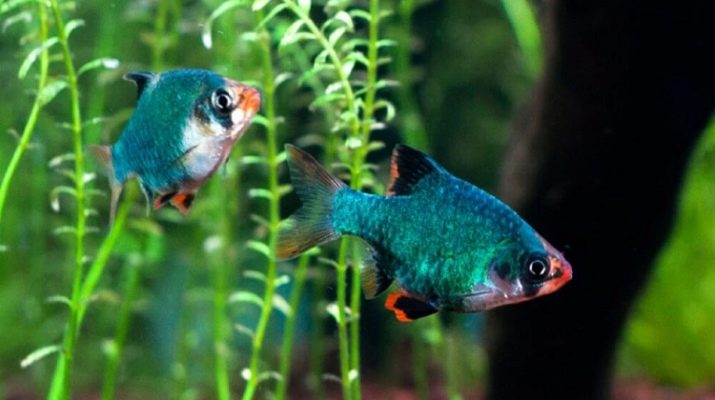
In most cases, the spawning process begins at dawn. If the fish do not spawn for two days, replace some of the water in the aquarium. You also need to raise the temperature by 2 degrees from the usual. When spawning, the acidity of water should be 6.0 pH, dH - up to 5 units.
The female lays about 200 eggs at a time. These are transparent bubbles with a yellow tint. The male immediately fertilizes them. After a couple, you need to immediately put it in another container to avoid eating caviar. Add methylene blue to the water. After 36 hours, larvae will appear from the eggs.
During the first 5 days they will feed on the contents of the yolk sac. After the fry, you need to feed the ciliates. Microworms will do. As they grow, they switch to larger feeds. Accurate information on how often barbs hatched eggs is not available. It all depends on the conditions.
In certain cases, fish can spawn almost every week. Some aquarists note that this process takes less than a month.

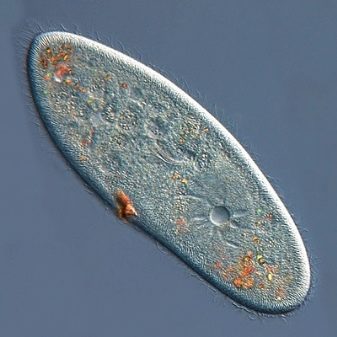
Disease
If the living conditions are not favorable, mossy barbs can suffer from infectious diseases. The most common are aeromonosis and rubella. To avoid them, you need to keep the aquarium clean and periodically change the water. Do not forget about mandatory quarantine for new aquarium inhabitants.
When using poor quality food, severe poisoning of fish is possible. If you do not adhere to the feeding schedule, they become obese. In all other cases, this species has excellent stamina and rarely gets sick.
On how to properly breed a mossy barbus, see the next video.










